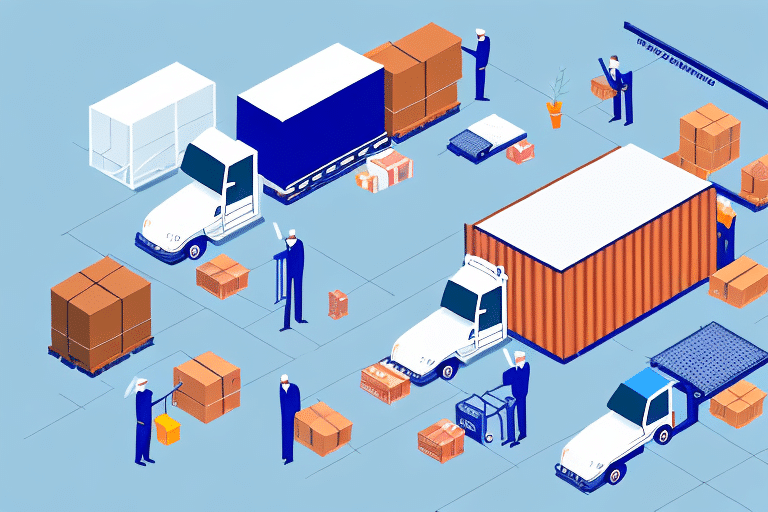How to Leverage 3PLs for Effective Ecommerce Growth
If you are running an ecommerce business, you may have come across the term "3PL" before. The acronym stands for "third-party logistics," and it refers to companies that offer storage, fulfillment, and shipping services to businesses. In this article, we will explore what 3PLs are, how they work, and why they can be a game-changer for ecommerce growth.
Understanding 3PLs: What They Are and How They Work
A 3PL is a company that specializes in logistics services. This can include everything from warehousing and inventory management to order fulfillment and shipping. When you partner with a 3PL, you essentially outsource these logistics tasks to them. This allows you to focus on growing your business while the 3PL takes care of the backend operations.
Typically, you will provide your 3PL with your products, which they will store in their warehouse. When a customer places an order on your website, the 3PL will receive the order information, pick the products from their inventory, pack them, and ship them directly to the customer. They will also handle any returns or exchanges.
According to a Statista report, the global 3PL market is expected to reach over $220 billion by 2025, highlighting the significant role 3PLs play in the ecommerce industry.
One of the benefits of using a 3PL is that they often have access to discounted shipping rates due to their volume of shipments. This can save you money on shipping costs and allow you to offer competitive pricing to your customers. Additionally, many 3PLs offer advanced technology and reporting capabilities, giving you real-time visibility into your inventory levels and order status. This can help you make informed decisions about your business and improve your overall efficiency.
Advantages and Disadvantages of Using 3PLs
Pros of Using 3PLs
- Time and Cost Savings: Partnering with a 3PL can save you time, money, and resources. You won't have to worry about investing in your own warehouse, hiring staff to manage logistics, or dealing with the complexities of shipping and handling.
- Expertise and Infrastructure: A good 3PL will have the expertise and infrastructure to handle logistics tasks efficiently and effectively.
- Access to Technology: Many 3PLs provide advanced technology solutions for inventory management, order processing, and real-time tracking.
- Scalability: 3PLs can scale their services to accommodate your business growth, seasonal fluctuations, and peak sales periods.
Cons of Using 3PLs
- Reduced Control: Outsourcing logistics means you have less direct control over the processes, which could lead to challenges in maintaining quality and consistency.
- Communication Issues: Working with a third-party provider can sometimes lead to communication gaps or misunderstandings.
- Brand Control: There's a risk of losing some control over your brand's customer experience, especially if the 3PL fails to meet your standards.
- Costs: While 3PLs can save you money, their services come at a cost, and pricing structures can vary significantly between providers.
Selecting the Right 3PL Partner for Your Ecommerce Business
Choosing the right 3PL provider is crucial for your ecommerce success. Here are some key factors to consider:
Experience
Look for a 3PL that has experience working with businesses similar to yours. They should have a track record of success and be able to provide case studies or references upon request.
Technology
Ensure the 3PL you choose has robust technology and systems in place. Look for features like real-time tracking, integration with your ecommerce platform, and detailed reporting capabilities.
Costs
Understand the pricing structure of each 3PL you are considering. Some providers charge a flat rate, while others charge based on storage or shipping volume. Make sure you comprehend the costs involved and how they may impact your bottom line.
Location
Consider the geographic location of the 3PL. Ideally, partner with a provider that is strategically located near your key markets to minimize shipping costs and transit times.
Customer Service
The level of customer service offered by the 3PL is another important factor. Choose a provider that is responsive and offers clear communication channels, such as a dedicated account manager or support team.
Integrating and Managing Your Relationship with a 3PL
Successfully integrating a 3PL into your ecommerce operations requires careful planning and management:
Integration with Ecommerce Platform
Ensure that your ecommerce platform can seamlessly integrate with the 3PL's systems. This typically involves API integration, data mapping, thorough testing, and possibly customization to fit your specific needs.
Effective Communication
Maintain open and clear communication with your 3PL provider. Regularly discuss any issues, updates, or changes in your business to ensure both parties are aligned.
Reporting and Analytics
Utilize the reporting and analytics tools provided by your 3PL to monitor key metrics such as inventory levels, order fulfillment rates, and shipping times. Use this data to identify areas for improvement.
Continuous Collaboration
Work collaboratively with your 3PL to optimize operations. This might include exploring new technologies, refining processes, or jointly addressing challenges to improve efficiency and effectiveness.
Measuring and Optimizing the Success of Your 3PL Partnership
Setting Key Performance Indicators (KPIs)
Establish clear KPIs to measure the success of your 3PL partnership. These might include:
- Order Accuracy
- Shipping Times
- Inventory Accuracy
- Cost Savings
- Customer Satisfaction
Utilizing Customer Feedback
Gather feedback from your customers regarding their fulfillment experience. This can provide valuable insights into how well your 3PL is performing and areas that may need improvement.
Tracking Cost Savings
Monitor the cost savings achieved through your 3PL partnership by comparing the costs of in-house logistics operations versus outsourcing to a 3PL, as well as tracking expenses related to shipping, warehousing, and other logistics services.
Evaluating Flexibility
Assess the flexibility of your 3PL partner in adapting to your changing business needs. This includes their ability to handle fluctuations in order volume, adjust shipping schedules, and provide additional services as required.
Common Mistakes to Avoid When Working with a 3PL in Ecommerce
Working with a 3PL can be highly beneficial, but it's important to avoid common mistakes that can derail the relationship. Here are some pitfalls to avoid:
- Not Doing Your Research: Don't partner with a 3PL provider without first doing your due diligence. Make sure you understand their experience, technology, costs, and any other factors that may impact your partnership.
- Underestimating the Importance of Communication: Effective communication is crucial to a successful 3PL relationship. Make sure you are communicating frequently, clearly, and proactively with your partner.
- Ignoring Metrics and KPIs: Don't assume that your 3PL provider is managing your logistics operations perfectly. Keep track of key metrics and KPIs, and use this data to identify areas for improvement.
Tips for Optimizing Your Supply Chain with a 3PL Partner
Finally, here are some tips for optimizing your supply chain with the help of a 3PL partner:
- Use Data to Drive Decisions: Analyze your logistics data to identify trends and opportunities for improvement. Use this data to make data-driven decisions about your logistics operations.
- Collaborate with Your 3PL Provider: Work collaboratively with your 3PL partner to identify areas for improvement and new ways to optimize your supply chain.
- Invest in Technology: Consider investing in technology that will help you optimize your logistics operations, such as automated inventory management systems or real-time tracking tools.
Real-World Success Stories: Ecommerce Growth with 3PLs
Here are some real-world examples of businesses that have successfully leveraged 3PLs to grow their ecommerce operations:
- Boxed: Boxed, a leading online retailer of bulk groceries and household items, relied on a 3PL partner to help scale their fulfillment operations and improve shipping times.
- TULA Skincare: TULA Skincare, a beauty brand that sells products online and in retail stores, partnered with a 3PL to streamline their inventory management and order fulfillment processes.
- Harry's: Harry's, a popular men's shaving brand, worked with a 3PL partner to develop a custom logistics solution that effectively managed their inventory, fulfillment, and shipping operations.
By partnering with a 3PL, these businesses were able to focus on growth and innovation while letting their logistics operations run smoothly and efficiently in the background.




















